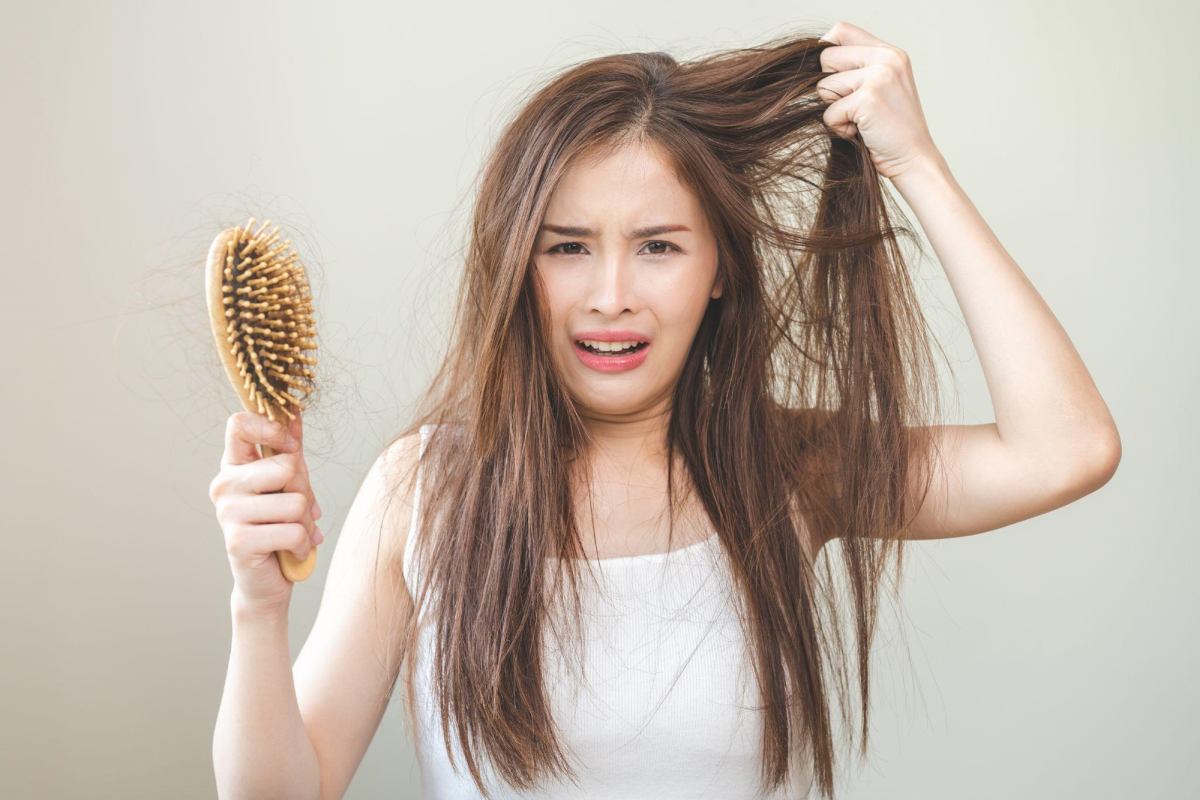Winter brings unique challenges for hair health, making it the perfect season for salons to expand their treatment offerings. As clients battle harsh weather conditions, they increasingly seek professional hair care products that deliver real results. Savvy stylists know that having a comprehensive winter treatment menu boosts revenue and helps maintain client hair health during these challenging months. So, what winter hair treatments should you be offering your clients? Keep reading to find out!
Table of Contents
Understanding Winter Hair Woes
Kmpzzz/Shutterstock.com
The winter season presents distinct challenges for hair health. Cold outside air combined with dry indoor heating creates a perfect storm for dehydration and damage. Static electricity becomes more prevalent, and friction from scarves and hats can lead to breakage. Understanding these seasonal challenges helps stylists recommend the most effective treatments for their clients’ specific needs.
1. The Power of Protein Treatments
Protein treatments can be a game-changer when hair becomes compromised during winter months. These intensive treatments work by penetrating the hair shaft to rebuild and strengthen damaged areas. While many clients might attempt at-home treatments, salon-administered protein services provide deeper penetration and more lasting results. Proper application and timing are vital, as too much protein can lead to brittleness.
2. Bond-Building Services
Modern bond-building treatments represent a revolutionary approach to hair repair. These treatments work at the molecular level to restore broken bonds within the hair structure. Unlike traditional conditioning treatments, bond builders actually reconstruct damaged areas rather than simply coating the surface. This makes them particularly valuable during winter when hair faces increased stress from environmental factors.
3. The Rise of Hair Gloss Treatment
Hair gloss treatments have become increasingly popular as clients seek ways to combat winter dullness. These treatments seal the hair cuticle and add brilliant shine while providing essential moisture. As a stylist, you can customize them to either enhance your client’s current color or add clear shine, making them versatile enough for every client.
4. Deep Conditioning Innovations
The evolution of salon quality conditioners has transformed traditional deep conditioning services. Modern formulations combine multiple active ingredients to address various hair concerns simultaneously. Offering tiered conditioning services — from express treatments to intensive therapy sessions — allows stylists to meet diverse client needs and budgets.
5. Scalp Therapy Services
Healthy hair begins with a healthy scalp, and winter often exacerbates scalp issues. Incorporating specialized scalp treatments into your service menu addresses the root of many winter hair problems. These treatments can include scalp exfoliation, moisturizing masks, massages and stimulating therapies that promote better circulation and hair growth.
6. Custom Oil Treatments
Parilov/Shutterstock.com
Oil treatments provide essential moisture and protection during harsh winter weather. The secret is customizing the oil blend to each client’s specific hair type and concerns. Fine hair benefits from lightweight oils like argan or jojoba, while coarser textures need richer options like coconut or castor oil. Professional application techniques ensure optimal absorption without leaving residue.
7. Color Protection Treatments
Winter can be particularly harsh on color-treated hair. Offering specialized color protection treatments helps maintain vibrancy between color services. These treatments often combine UV protection with moisturizing and strengthening ingredients to preserve color integrity while protecting your clients’ tresses from environmental damage.
8. Keratin Service Variations
While traditional keratin treatments remain popular, offering varied intensities of keratin services can better serve diverse client needs. From express smoothing treatments to complete restructuring services, having multiple options allows stylists to address different texture concerns while considering time and budget constraints.
9. Heat Protection Protocols
Heat protection is crucial with the increased use of heating tools during winter. Professional heat protection treatments create a barrier against both styling damage and environmental stress. You can incorporate these products into other services or offer them as standalone treatments for clients who regularly heat style.
10. Moisture Lock Treatments
Innovative moisture lock treatments help combat the dehydrating effects of winter weather and indoor heating. These treatments work by building a protective barrier that seals in moisture while allowing the hair to breathe. The results can last several weeks, making them an excellent investment for clients struggling with winter dryness.
11. Overnight Treatment Programs
Offering take-home overnight treatments as part of a professional service package extends the benefits of in-salon treatments. These specialized treatments work while clients sleep, providing intensive repair and moisture. Provide proper instruction on application techniques to ensure optimal results.
12. Combination Treatment Strategies
Creating customized treatment combinations allows stylists to address multiple concerns in one session. This might include combining scalp therapy with deep conditioning or bond building with color protection treatments. These comprehensive approaches provide better results and higher value for clients.
Don’t Forget Client Education
Successfully incorporating winter treatments into your service menu requires strong client education. Understanding the science behind these treatments helps clients appreciate their value and necessity, so take the time to explain it to them. Additionally, offer regular maintenance recommendations and home care advice to ensure lasting results between salon visits.
Marketing Your Winter Services
Effectively promoting winter treatment services requires strategic timing and clear communication of benefits. Creating seasonal packages and promotional materials highlighting the protective and reparative aspects of these treatments can drive service bookings during typically slower winter months.
Conclusion
Ekaterina GladSkikh/Shutterstock.com
Specialized winter hair treatments offer a significant opportunity for stylists to provide essential care while building client loyalty and increasing revenue. By offering a wide range of customizable treatments and educating clients about their benefits, salons can position themselves as trusted partners in winter hair care. The key is selecting and implementing treatments that deliver visible results while meeting the unique needs of your client base.
Remember that successful winter treatment services go beyond simply applying products. They require expertise in assessment, customization and application techniques. By staying current with treatment innovations and maintaining high standards in service delivery, stylists can help their clients maintain healthy, beautiful hair throughout the winter season and beyond.

